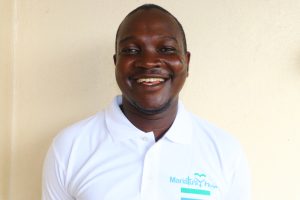The 505 students and 10 staff of DEC Mamankie Primary School struggle daily to have sufficient water. The Water Project converted an old well at the school in 2020, but sadly, due to climate change, it is no longer meeting the school's needs. It is not deep enough to produce enough water, particularly during dry seasons, so students must search for water elsewhere.

"Based on our monitoring, we found out that the water table of the converted well at the school also goes down, and that affects the school staff and pupils [in] getting water, especially in the dry season. When this well was originally rehabilitated, we hit a big rock and couldn't go any deeper," shared Field Officer Alimamy Kanu.

When the well is dry, the only alternative water source is the community's overcrowded, protected dug well.
The waterpoint is shared with community members and the large school population. It is not unusual for students to jostle to be first in line so they can return to school quicker because they waste valuable time waiting in long lines to collect water. This leads to fights and tension among those collecting, especially students, which inevitably creates an environment of hostility in the classroom that is not ideal for learning.

The community well.
Fourteen-year-old Wara is familiar with the frustrating experience of trying to find water while at school.
"In the dry season, the school waterpoint always gets dry, and I always go out of the school to fetch water. As such, fetching water takes so long, due to the distance and the crowd at the water source. I need to wait for my turn before greeting water. There are other people who are older than me that always push me [to] the back when they want to fetch water. The distance to the water source is another reason why fetching water takes so long," said Wara.

Wara carrying water.
"When I am sent to go and fetch water, I always feel unhappy due to the crowd at the water source. Those who are older than me always treated me unkindly just to get water before me. Sometimes, I may even return home without getting water," she continued.
Wara would rather be in the classroom focusing on her lessons than be responsible for searching for water. Without sufficient time to learn, she is fighting a constant battle to succeed in school and make progress in the future.

"The persistent scarcity of water in the school, especially in the dry season, affects my time at the school and my exam scores. I [am] always late to go to school when there is a scarcity of water within the community. That will always make me miss some lessons that are important," said Wara.

Wara.
Wara and the other students need a reliable, safe water source on their school campus that will provide sufficient water to meet all of their needs so they can return to the classroom and build a brighter future.
Steps Toward a Solution
Our technical experts worked with the local community to identify the most effective solution to their water crisis. They decided to drill a borehole well, construct a platform for the well, and attach a hand pump.
Well
Abundant water often lies just beneath our feet. Aquifers—natural underground rivers—flow through layers of sediment and rock, offering a constant supply of safe water. A borehole well is drilled deep into the earth to access this naturally filtered and protected water. We penetrate meters, sometimes even hundreds of meters, of soil, silt, rock, and more to reach the water underground. Once found, we construct a platform for the well and attach a hand pump. The community gains a safe, enclosed water source capable of providing approximately five gallons of water per minute. Learn more here!
School Education & Ownership
Hygiene and sanitation training are integral to our water projects. Training is tailored to each school's specific needs and includes key topics such as proper water handling, improved hygiene practices, disease transmission prevention, and care of the new water point. To ensure lasting impact, we emphasize engagement by students, staff, and community members to maintain their new waterpoint and implement their new knowledge, which encourages a sense of ownership and responsibility.
Safe water and improved hygiene habits foster a healthier future for everyone in the school and surrounding community.

 Borehole Well and Hand Pump
Borehole Well and Hand Pump
 Rehabilitation Project
Rehabilitation Project














